Trek Distance of Everest Base Camp
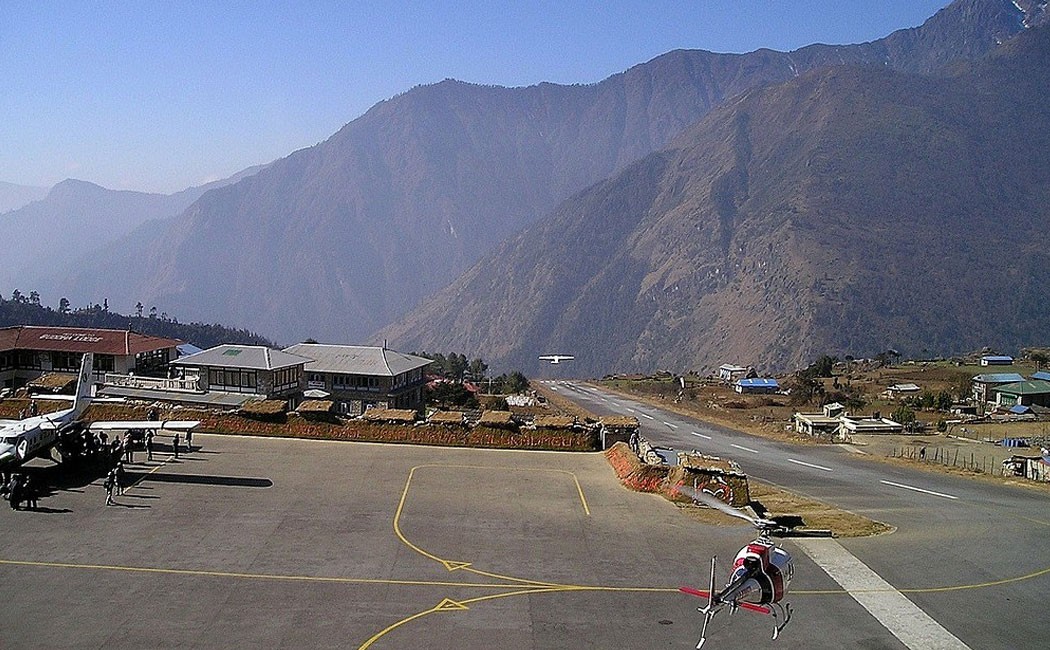
Kathmandu to Lukla to Phakding
The starting point of the Everest Base Camp Trek is Lukla at 2,860m. It’s a 130 km flight away from Kathmandu in Khumbu Valley. Once you arrive at the village, the adventure begins. It starts with a gentle ascent up the hill and along the bank of the Dudh Koshi River, which provides a great view. The trek takes almost 3 hours and requires us to climb those steep stone stairs and rugged trails. During the trek, you’ll see many beautiful villages, stupas, and chortens.
Phakding to Namche Bazaar
From Phakding, we’ll start the 14 km hike by following the Dudh Koshi River Valley and into the rhododendron forests. On the trek, we’ll climb thousand of steep meters passing through remote villages and significant landmarks. Once the trail enters Sagarmatha National Park, we’ll have challenging sections with an unflagging uphill walk.
The trek is quite exciting, as you’ll see some great stuff, but it’s nowhere close to the beautiful town of Namche. There’s a lot to see in Namche, like the Sherpa Museum, Namche Monastery, and Sagarmatha National Park. You can also enjoy a roundtrip hike to Everest Hotel View during a stop at the town.
Namche Bazaar to Tengboche
The day involves trekking a 9.5 km trail, which is incredibly challenging but also rewarding. We’ll start the trek after a day of acclimatization in Namche, so you’ll stay fully charged throughout the day.
We‘ll be hiking from the edge of the valley alongside northern trails and up toward Phunki Thanga. We’ll enter the forested paths and face another steep climb leading to Tengboche Monastery. After five hours of a strenuous hike, we’ll end up high at Tengboche.
Tengboche to Dingboche
The high alpine trek from Tengboche starts with a long ramp up and out of the valley. It involves trekking on a narrow, steep trail above the river valley and along the mountain ridge. The trail has us walking through the dense pine forest and crossing the Imja Khola River.
By this time, you’ll see a dramatic change in landscapes as high plateaus and mountains reinstate the wooded valleys. The section of this trek is mostly arid, with barren plains and mountains, but the atmosphere remains electric. While there’s not much to look at in the village, the surrounding lofty mountains and Imja River are magnificent.
Dingboche to Lobuche
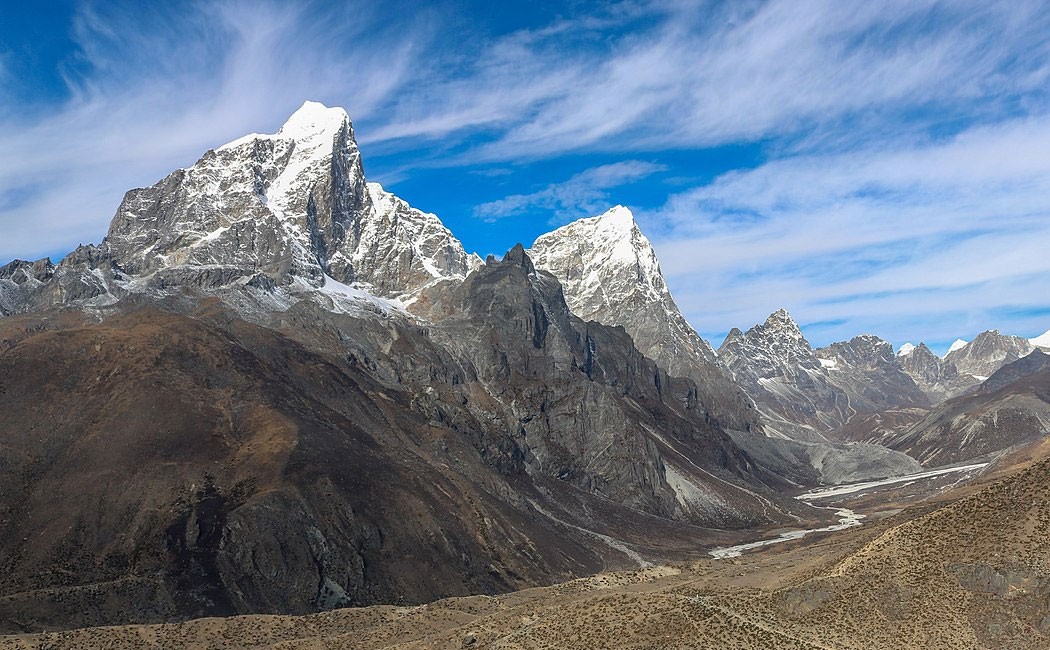 Due to the high altitude gain on Everest Base Camp trek, we’ll have a rest day in Dingboche before proceeding any further. After a break, the journey continues with a trek up the wide valley to the tiny village of Lobuche. The trail will lead us through the barren and deserted zone, where the rural settlement is very slim.
Due to the high altitude gain on Everest Base Camp trek, we’ll have a rest day in Dingboche before proceeding any further. After a break, the journey continues with a trek up the wide valley to the tiny village of Lobuche. The trail will lead us through the barren and deserted zone, where the rural settlement is very slim.
This 5-hour-long trek includes a pit stop at Dughla for lunch and rest. You can enjoy your time at the teahouse, watching the surrounding mountain loom large. As the trek continues, you’ll see old memorials built in memory of climbers who tragically perished in the mountain.
You can view the snow-clad mountains and rugged hills on your way up the village. When the trail ends at the junction, we’ll take the one leading to Zongla. The last 30 minutes of the trek will take us through the scenic village of Chola Tsho, where we'll take a short break to enjoy the views and catch our breath. From there, we'll continue on towards Lobuche, which is nestled in a narrow valley between the peaks of Lingtren and Khumbutse. This section of the trek can be quite challenging due to the altitude, but the incredible mountain scenery makes it all worthwhile.
Lobuche to Everest Base Camp
 The journey from Laboche starts off difficult, with a steep climb on rugged terrain. It takes us past the glacial moraine full of rocks and sandy lakebed. The view may seem rustic, but it’s quite enjoyable, with a great atmosphere. You can develop a camaraderie with fellow trekkers while on your way to the camp.
The journey from Laboche starts off difficult, with a steep climb on rugged terrain. It takes us past the glacial moraine full of rocks and sandy lakebed. The view may seem rustic, but it’s quite enjoyable, with a great atmosphere. You can develop a camaraderie with fellow trekkers while on your way to the camp.
The remote paths are still strenuous and take almost two hours to finish. After celebrating the victory, we’ll trek down to Gorakshep for the night. It’s a remote settlement at the foot of Kala Patthar, and you can’t overlook it.
Gorakshep to Kala Patthar to Pheriche
The journey from Gorakshep to Kala Patthar is another crucial part of the trek. It’s more like a detour that trekkers take to get the closest view of Mount Everest. The trek is a short but difficult climb with rocks and boulders.
Kala Patthar's elevation is higher than the everest base camp elevation in the trek. Several craggy peaks like Ama Dablam, Chumbum, and Taboche surround it, providing a spectacular view. After a successful run of Kala Patthar, we’ll descend the trail and continue our journey to Pheriche.
The stretch from Gorakshep is strangely long but easy. It’s mostly downhill, with twists and turns passing through some remote parts of the trek. We’ll walk past several villages, flora, and fauna on our way to Pheriche.
Pheriche to Namche
The hike down to Namche will keep us on the base camp route all along the way. The trail takes us down the mountain slope, passing through several mountainside villages like Dole and Pangboche. The trek from Dole is an easy one-hour ride to Phortse Tenga and further two hours walk to Mong Village. We’ll arrive at Lukla in the evening after finishing a four-hour journey.
Namche to Lukla
The last day of the Everest Base Camp Trek will take us back to the lane of memories. Soon as we leave the Namche Bazaar, the trail will reinstate our previous experience of trekking the picturesque mountain villages like Dole and Manjo. It will take us down the Dudh Koshi River Valley and through the dense pine forest. We shall reach Lukla at a good time, so you might spend the extra time exploring the town and enjoying the view for one last night.
Lukla to Kathmandu
It’s time to get ahead of our beautiful adventure and fly back to Kathmandu. The journey will last for about 30 minutes, which is nice, but it’s nowhere near the comfort you’ll get after reaching your hotel. You can take a rest if you’re fatigued; otherwise, go out and explore Thamel a bit.
Everest Base Camp Elevation
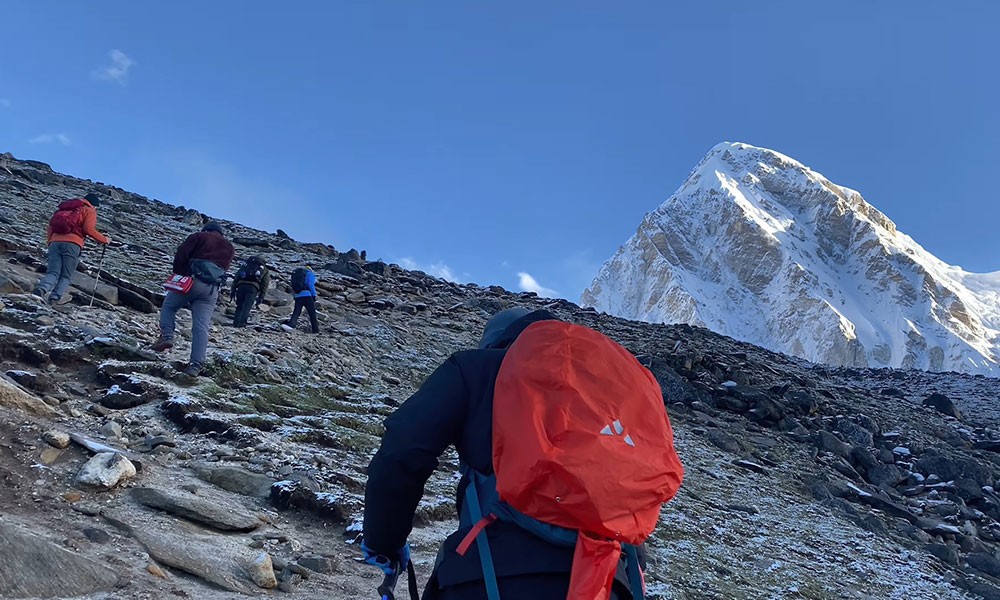 If anything tops the Everest Base Camp trek difficulty list, it’s the high altitude. As the altitude gain on Everest Base Camp trek increases, the trek shifts from moderate to challenging. The higher you go, the tougher the trek, and the impacts are extreme once you reach 3000 meters.
If anything tops the Everest Base Camp trek difficulty list, it’s the high altitude. As the altitude gain on Everest Base Camp trek increases, the trek shifts from moderate to challenging. The higher you go, the tougher the trek, and the impacts are extreme once you reach 3000 meters.
The trek from Phakding to Namche at 11,286 ft is generally more achievable. The trail is less threatening until this time, but as you go higher, the trail starts gaining elevation at a rapid pace, especially since you're approaching the Everest Base Camp elevation. Once you hit the 5000 meters height, the trail rises by 600 to 1000 meters each day, increasing the likeliness of altitude sickness.
The high altitude gain on Everest Base Camp trek makes the trek harder, especially if you’re suddenly exposed to the atmosphere. But, if you’re making your way up the camp from Phakding, the trek wil be less intimidating. You’ll have enough time to adjust to rest your body and adapt to the environment.
What are the difficulties of the Everest Base Camp Trek?
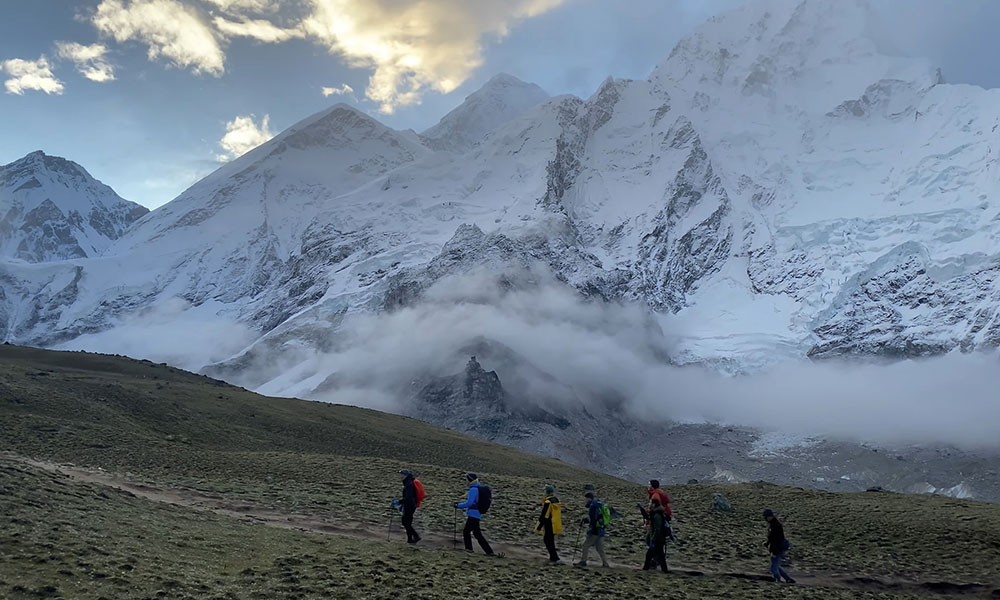 The Everest Base Camp Trek is a tough cookie. It’s hard and restrictive, with many challenges to outrun. The trek is arduous in many ways not everybody would consider. Hiking its trail is not an easy run, especially with a length of 130 km on a round trip.
The Everest Base Camp Trek is a tough cookie. It’s hard and restrictive, with many challenges to outrun. The trek is arduous in many ways not everybody would consider. Hiking its trail is not an easy run, especially with a length of 130 km on a round trip.
The hike up the mountain is highly demanding, with several steep slopes and deep valleys. Moving from that, you have sheer mountain ridges and rugged terrains, which are equally infuriating and troublesome.
The radical shift in terrain from the thick coniferous forests of Khumbu Valley to Gokyo’s glacial moraines makes the hike tricky. The swift altitude gain on Everest Base Camp trek causes further havoc. It exposes trekkers to acute mountain sickness, which shows in the form of headaches, nausea, fatigue, and dizziness.
Due to the low atmospheric pressure and thin air, trekkers have difficulty breathing at the higher altitude. The pace and prowess of hiking the trail also decline at the mounts, making trekkers even more vulnerable.
The unpredictable weather and climate conditions of Everest Base Camp contribute hugely to the difficulty level. Bear in mind the trek is more precarious in winter than at any other time. Heavy snowfall, high winds, overcast weather, and storms cause travel delays, flight cancelation, and evacuation.
The trekking adventure of Everest Base camp isn’t as glamorous as you think. In a nutshell, the accommodation conveniences in lodges and guesthouses will be rudimentary. Teahouses remain the only choice for budget trekkers, mostly at higher altitudes with limited service.
Essential tips for Everest Base Camp Trek
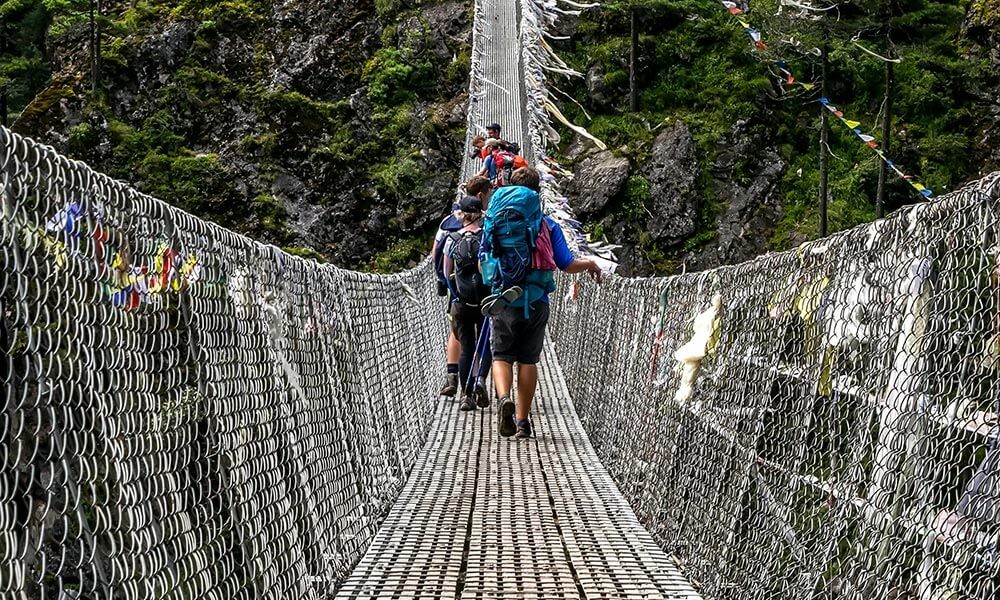 Everest Base Camp Trek may seem like a moderate hike, but it indeed is not a walk in the park. The trek is physically demanding, with long, rugged trails that take almost two weeks to hike. It requires walking along the mountain path and into the dense tropical forests, which needs considerable skill. The trekkers can’t come unprepared on the trek. They have to be well-informed and well-prepared before hiking the Everest Base Camp. Here are some of the tips for trekkers of Everest Base Camp.
Everest Base Camp Trek may seem like a moderate hike, but it indeed is not a walk in the park. The trek is physically demanding, with long, rugged trails that take almost two weeks to hike. It requires walking along the mountain path and into the dense tropical forests, which needs considerable skill. The trekkers can’t come unprepared on the trek. They have to be well-informed and well-prepared before hiking the Everest Base Camp. Here are some of the tips for trekkers of Everest Base Camp.
1. Prepare for all weather conditions
It’s no secret that the weather pattern in the mountains is unpredictable. It’s inconsistent and widely varying, which causes trouble for hikers. So, be prepared cause the last thing you want is to be stranded on the trail in torrential rain or storm.
General information and search on the weather can save you a day. It can alarm you about possible blizzards, windstorms, landslides, and rain. This is particularly important when trekking the hilly terrains, which are risky during extreme weather conditions.
2. Hire a Guide and Porter
Going solo on Everest Base Camp Trek is a terrible idea in any given case. It’s not wise to hike the trail on your own, mostly considering the ride away and the difficulty level of the trek. You can lose your way while on the trail or get yourself in trouble. Hiring a guide is a great step forward, as they can navigate you through the trail.
Your local trek guides can help and guide you through the process, especially when you're trekking towards the Everest Base Camp elevation. They’ll analyze the length and difficulty level of the trek to give you good advice when doing the trek. Apart from a guide, you must also hire a porter to help you with a backpack. This will make your journey easier and less strenuous, particularly as you ascend towards the higher parts of Everest Base Camp elevation.
3. Trekking gears and equipment
If there’s one thing that trekkers must have on any hike is the right trekking equipment. Without the important piece of gear, the trekkers will struggle on the trail. Remember, the travel agency only provides trekkers with a bare minimum of essentials. So, if something needs to be added to the backpack, you might get it just before the trek. You must ensure that you have all the
4. Pack lightly
Everest Base Camp Trek is a teahouses trek, so accommodation services are available all along the way. You don’t need to bring anything and everything on the trek. Just keep it as light as possible by carrying only those essentials that are a must. Stuffing your backpack with unnecessary items is just not worth it, especially when you’re doing a trek like base camp.
5. Drink Water
Trekkers often lose water quickly at a higher altitude. Since the body works harder, with altitude gain on Everest Base Camp trek, to get more oxygen, to stay hydrated is essential. You must drink at least 3 to 4 liters of water to avoid altitude sickness. Natural water sources are available everywhere in the Himalayas, but they might not all be drinkable from a health viewpoint. So bring a water purifier and a bottle so you can store water and drink it all along the way.
You may also like:
Final Say
Everest Base Camp Trek is a multi-day hike through the pristine valleys and remote Khumbu villages. It’s the most rewarding hike in Nepal, with spectacular views of Everest and other highest peaks.
The trek covers a distance of 130 km on a long and arduous journey to Everest Base Camp. It’ll take you to many places within and beyond the Sagarmatha National Park. There are many stops and crossings before the trail ends at the base camp. You’ll trek from 7 to 14 days, depending on the itinerary and the length of the trek. Overall, the Everest Base Camp Trek distance should not discourage free trekkers from embarking on this once-in-a-lifetime journey to one of the most legendary destinations in the world.

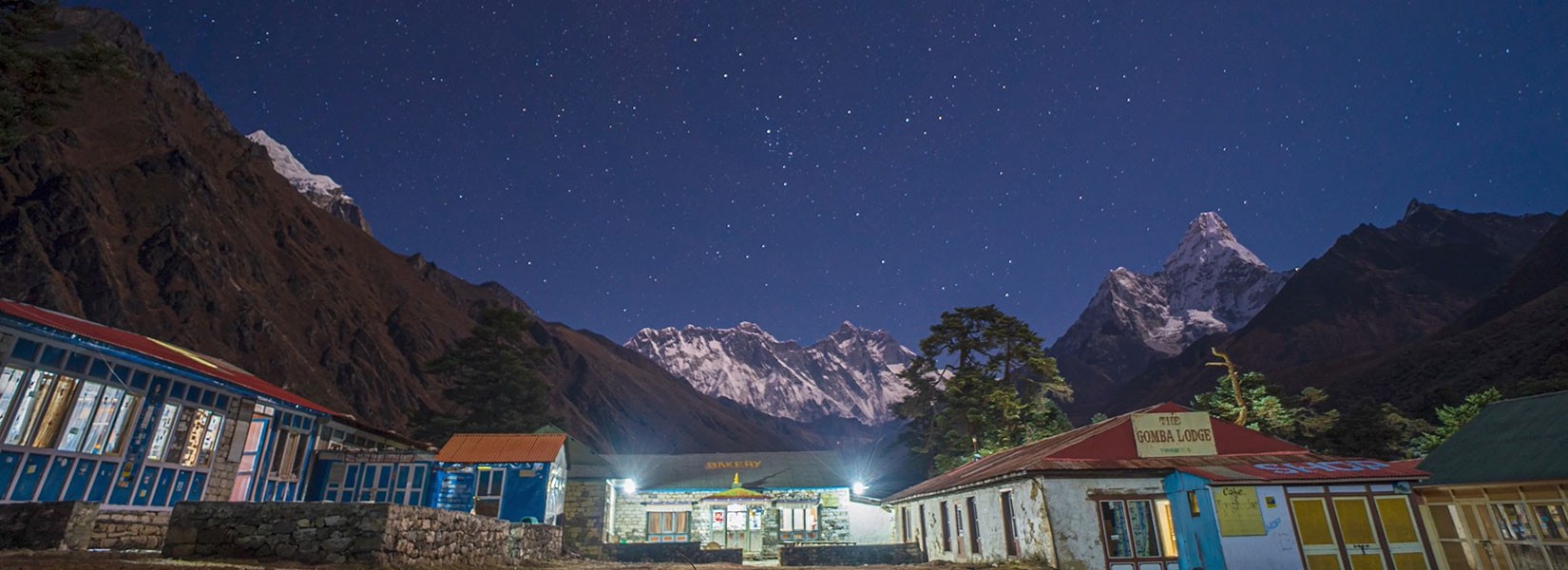


 Due to the high altitude gain on Everest Base Camp trek, we’ll have a rest day in Dingboche before proceeding any further. After a break, the journey continues with a trek up the wide valley to the tiny village of Lobuche. The trail will lead us through the barren and deserted zone, where the rural settlement is very slim.
Due to the high altitude gain on Everest Base Camp trek, we’ll have a rest day in Dingboche before proceeding any further. After a break, the journey continues with a trek up the wide valley to the tiny village of Lobuche. The trail will lead us through the barren and deserted zone, where the rural settlement is very slim. The journey from Laboche starts off difficult, with a steep climb on rugged terrain. It takes us past the glacial moraine full of rocks and sandy lakebed. The view may seem rustic, but it’s quite enjoyable, with a great atmosphere. You can develop a camaraderie with fellow trekkers while on your way to the camp.
The journey from Laboche starts off difficult, with a steep climb on rugged terrain. It takes us past the glacial moraine full of rocks and sandy lakebed. The view may seem rustic, but it’s quite enjoyable, with a great atmosphere. You can develop a camaraderie with fellow trekkers while on your way to the camp. If anything tops the
If anything tops the  The Everest Base Camp Trek is a tough cookie. It’s hard and restrictive, with many challenges to outrun. The trek is arduous in many ways not everybody would consider. Hiking its trail is not an easy run, especially with a length of 130 km on a round trip.
The Everest Base Camp Trek is a tough cookie. It’s hard and restrictive, with many challenges to outrun. The trek is arduous in many ways not everybody would consider. Hiking its trail is not an easy run, especially with a length of 130 km on a round trip. Everest Base Camp Trek may seem like a moderate hike, but it indeed is not a walk in the park. The trek is physically demanding, with long, rugged trails that take almost two weeks to hike. It requires walking along the mountain path and into the dense tropical forests, which needs considerable skill. The trekkers can’t come unprepared on the trek. They have to be well-informed and well-prepared before hiking the Everest Base Camp. Here are some of the tips for trekkers of Everest Base Camp.
Everest Base Camp Trek may seem like a moderate hike, but it indeed is not a walk in the park. The trek is physically demanding, with long, rugged trails that take almost two weeks to hike. It requires walking along the mountain path and into the dense tropical forests, which needs considerable skill. The trekkers can’t come unprepared on the trek. They have to be well-informed and well-prepared before hiking the Everest Base Camp. Here are some of the tips for trekkers of Everest Base Camp.

